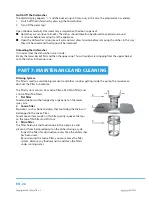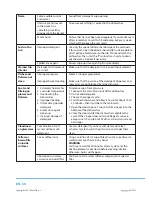
EN - 15
Copyright © 2016, Fast ČR, a. s.
02/2016
1
To open the dispenser, turn the cap to the "open" (left) arrow and lift it out.
2
Pour the rinse aid into the dispenser, be careful not to overfill.
3
Replace the cap by inserting it aligned with "open" arrow and turning it to the "closed" (right) arrow.
The rinse aid is released during the final rinse to prevent water from forming droplets on your dishes that can
leave spots and streaks. It also improves drying by allowing water to sheet off the dishes.
Your dishwashers are designed to use liquid rinse aids. The rinse aid dispenser is located inside the door next
to the detergent dispenser.
To fill the dispenser, open the cap and pour the rinse aid into the dispenser until the level indicator turns
completely black. The volume of the rinse aid container is about 140ml.
Be careful not to overfill the dispenser, because this could cause over sudsing. Wipe away any spills with
a damp cloth. Don't forget to replace the cap before you close dishwasher door.
Attention!
Clean up any rinse aid split during filling with an absorbent cloth to avoid excess foaming during the next
wash.
Adjusting Rinse Aid Dispenser
The rinse aid dispenser has four or six settings. Always start with the
dispenser set on "4" If spots and poor drying are problems, increase
the amount of rinse aid dispensed by removing the dispenser lid and
rotating the dial to "5". If the dishes still are not drying properly or are
spotted, adjust the dial to the next higher number until your dishes are
spot-free. The dose is factory set in the position 5.
NOTE:
Increase the dose if there are drops of water or lime spots on the dishes after washing.
Reduce it if there are sticky whitish streaks on the dishes or a bluish film on glassware or knife blades.
D.
Function of Detergent
Detergents with its chemical ingredients are necessary to remove dirt, crush dirt and transport it out of the
dishwasher. Most of commercial quality detergents are suitable for this purpose.
Concentrated Detergent
Based on their chemical composition, dishwasher can be split in two basic types:
conventional, alkaline detergents with caustic components
low alkaline concentrated detergents with natural enzymes
The use of "Eco" washing programme in conjunction with concentrated detergents reduces pollution and is
good for your dishes; these washing programmes are specially matched to the dirt-dissolving properties of
the enzymes of the concentrated detergent. For this reason "Eco" washing programme in which concentrated
detergents are used can achieve the same results that can otherwise only be achieved using "intensive"
programme.
1
2
3
4
5
6
MAX
Adjust lever
(Rinse)
Содержание PD 1273 BiT
Страница 1: ...PD 1273 BiT DISHWASHER USER MANUAL ...






























